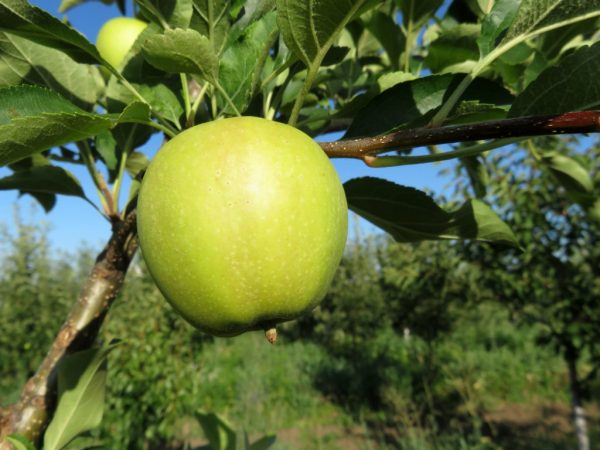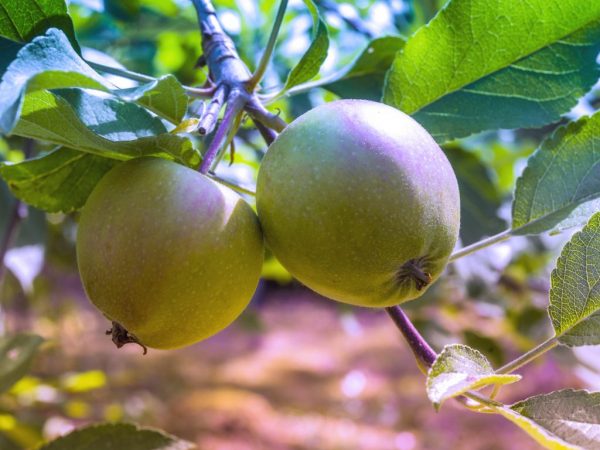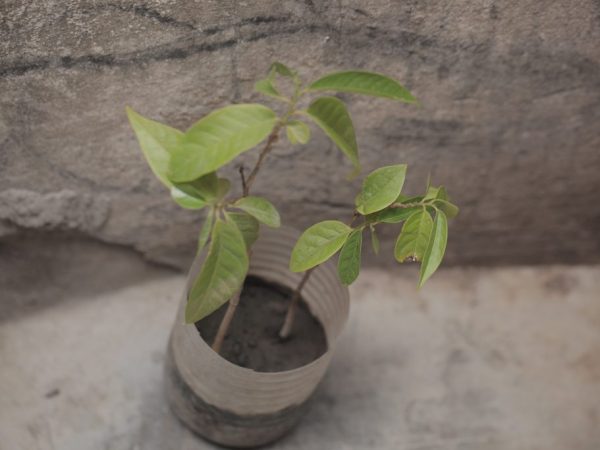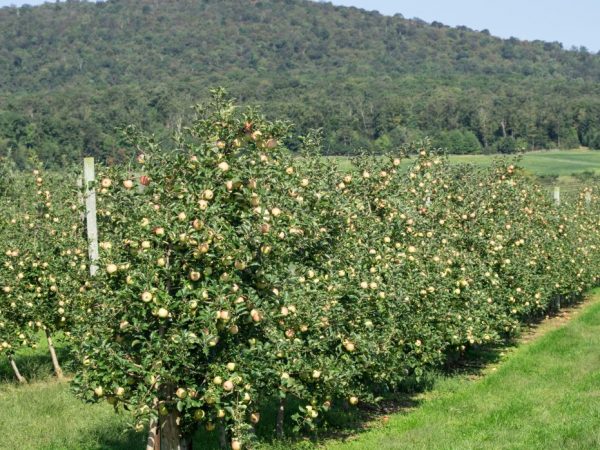Cultivation of an apple tree "Kandil Orlovsky"
The apple tree "Kandil Orlovsky" has established itself quite recently. They brought it out thanks to the great and fruitful work of scientists. The project at that time was led by academician Sedov, it was he who found the necessary varieties of apples to cross them. Since 2002, the variety has been grown and sold in the markets.
- Characteristics of the variety
- Description of the tree
- Fruit characteristics
- Benefits
- Yield
- Self-fertility
- Pollinators
- Taste
- Winter hardiness
- Disease and pest resistance
- Growing region
- Landing
- Landing dates
- Landing technology
- Care
- Watering
- Top dressing
- Pruning and shaping the crown
- Disease and pest control
- Features of ripening and fruiting
- Harvesting and storage
- Subspecies and variants
- Gardeners' reviews about this variety

Cultivation of an apple tree Kandil Orlovsky
Characteristics of the variety
All fruits have their own size, shape, color and smell.
The apple tree "Kandil Orlovsky" has its own parameters, according to which it is easy to differentiate with other varieties.
Description of the tree
The tree is small, medium in size, round crown and not very dense. The main branches in relation to the trunk are at an angle of 90 °, but they are quite rare and have a curved shape. Under the weight of the fruits, all branches droop, they can break, so it is advisable to support them with something.
According to the description, the leaves of the tree are dark green, curved downward and resemble the shape of eggs, only with a pointed tip.
Kandil's bark is brown, which is typical only for this kind of apples. It is smooth to the touch, especially in the area of the trunk and skeletal shoots. The tree has a well-developed root system. Saplings grow to the ground and it is difficult to remove them from the soil already at the age of two.
Fruit characteristics
The apples are yellow with a pink or crimson blush. There are almost no subcutaneous spots on them. By weight, one fruit is approximately 120-140 g, and there are also 180 g.
The pulp is juicy and crispy, the taste is sweet, with a subtle sour note. They have a high vitamin C value.
The apple has a small peduncle of medium length. The funnel in which it is located is shallow, narrow and has an acute-conical shape. The fruit saucer is deep, but also narrow, with characteristic grooves.
Benefits
- early fertility;
- resistance to scab attack;
- extensive productivity;
- tolerates winter well;
- has a high demand for a buyer;
- lends itself to transportation.
Disadvantages: the apple tree needs to be watered and looked after on time, otherwise the fruits will crumble, and the harvest will be lost for a year. For a tree to bear fruit, it needs pollinators.
Yield
The Kandil Orlovsky variety usually pleases with its yield, because from one apple tree per season, you can get up to 150 kg of fruit.
If a hectare of apples is planted, at least 30 tons of them will come out, and this will be so every year. The variety itself is fast-growing, an excellent harvest can be harvested as early as 4-5 seasons after planting the seedling, and on dwarf species - on the 3rd.

The apple tree will delight you with its yield
The fruits quickly ripen on a seed stock, at the age of 5 years a young apple tree can already give up to 100 kg of fruits, and more than 120 kg can be harvested from a dwarf variety.
Harvesting can begin in mid-September and can be stored until mid-March if conditions are met.
Self-fertility
The apple tree "Kandil Orlovsky" has high self-fertility, but this will not play a special role if there is only one tree in the garden.
If there are already 5 to 15 seedlings, the harvest will be more noticeable. It is worth foreseeing self-fertility, therefore, the tree must be properly looked after.
Pollinators
The apple tree practically cannot bear fruit on its own - it needs pollinators. To do this, plant Antonovka ordinary, Aphrodite, Venyaminovka, Orlik or Freshness.
Taste
The taste of apples is quite rich, sweet and sour, the pulp is small and has a lot of juice inside. The apple aroma is clearly audible, which immediately speaks of the quality of the fruit.
Winter hardiness
Orlovsky Kandil has adapted to cold weather conditions, yields a harvest even in cold and harsh weather conditions.
Disease and pest resistance
The apple tree is quite resistant to scab attacks, but still sensitive to some types of pests, which is why it requires special care.
It can be struck by flower beetles, aphids, sawflies, therefore, before flowering, it is necessary to periodically spray the bark of a tree with insect repellents - insecticides.
Growing region
From the very beginning, the variety was bred in areas where there was a lot of black soil: these are the Central, Chernozem and North Caucasian regions.
But the apple tree can grow at low temperatures, so now this variety is grown almost throughout the territory of modern Europe, in Russia (especially in Altai).
Landing
For an apple tree to be productive, you need to know how and where to plant it. First you need to choose a good location.
Orlovsky Kandil does not like dull terrain, so it is better to choose a sunnier place, so it will be possible to avoid a drop in the yield level and save the tree.
Landing dates
A good time to plant in September or April.
Landing technology

For a seedling, you must carefully select a site
There are many nuances that need to be taken into account when planting the Orlovsky Kandil.
- First you need to find the right site. These can be soils that absorb water well, have a mixture of soil and sand - chernozem with a low level of acidity, or sandy soil, which will be fed and fertilized in a timely manner.
The apple tree categorically does not tolerate stagnant water. So the tree can rot in a short time.
- For planting seedlings, you need to prepare pits, the width of which will be about 80 cm, depth - 1 m. After a while, the ground in the pits will settle. If there is a possibility of flooding on the site, drainage must be done.
- To do this, in the lowest part of the pit, you need to drill a channel with a depth of 1.5 m, then you need to fill it up with gravel, broken brick, so that the water can pass calmly.
- Now the soil for the tree must be fertilized with something in order to increase the yield. Humus works well for this. You can use peat or mineral components.
- You can plant a tree only when the soil has settled, and this usually takes about two weeks. A peg must be driven into the ground. After two weeks, plant trees, but do not deepen it. It is necessary to control that the place where the root passes into the trunk is 5 cm higher than the soil.
After planting, the seedling needs to be tied to a peg, this will help the tree grow upward without bending or leaning to the other side. The roots are covered well with earth, and then watered abundantly with water. A month after planting, the apple tree is fed with any rooted plant.
This procedure stimulates the growth of the tree and affects the speedy adaptation to the weather conditions of the area.
To make the crown of the tree thicker and grow faster, it is cut by a third before planting. Branches are cut on the seedling, but no one touches the roots. If the root system of a tree is poorly developed, 90% of the leaves are plucked from it.
Care
Care is necessary so that the tree grows better every year, and also increases the yield.
Watering
The main watering is important immediately after planting: it must be watered generously with water, and then, before flowering, look at the weather conditions.
The apple tree does not like much water. When the period of flowering and fruit setting comes, it is imperative that the tree is watered with 2-3 buckets of water every 4-7 days.
Top dressing
Top dressing for Kandil is very important. In the spring, a nitroammophoska is suitable. It must be dissolved in 10 liters of water, adding 1 tablespoon, and then poured under a tree. In the spring, wood ash is added in dissolved form, in an amount of 300 g.
Top dressing is necessary during the flowering period of the tree. At this time, potassium chloride and superphosphate are selected, in the amount of 1 tsp. under a tree, and in the fall - again 300 g of wood ash.
Pruning and shaping the crown
It is advised to carry out this procedure for an already mature tree every six months for rejuvenation.
Only damaged or dry shoots are cut when the buds have not yet blossomed. This usually happens at the beginning of spring.
After planting, when there is already the first color, it must be cut off. Remove almost everything. So the tree will adapt faster and bear fruit.
Further, you can cut off only excess fruits, which are very small in size.
If this is not done, then the tree itself will get rid of the excess, but its fruits will no longer be so sweet and smaller.
Disease and pest control

The variety is resistant to diseases
Apple trees of the Kandil variety are in great demand and popularity, because they have immunity to scab, as well as fungal diseases.
Sometimes it is attacked by aphids, apple blossom beetle or sawfly. To protect from pests, it is enough to treat the crown with insecticides, burn dry branches and leaves.
Features of ripening and fruiting
After planting the Kandil apple tree, the first fruits appear in 3-5 years, sometimes after 2 years you can see several small apples, up to 5 pieces.
Some people manage to collect a bucket of fruits after 2 years, but they are not yet so tasty. It is better to tie up tree branches up to 3 years.
Flowering almost always occurs in the spring. In this case, it is May. The fruits ripen until October, depending on the weather conditions.
Speaking of fruiting, we can say that yield decreases with age.
Harvesting and storage
Usually the crop is harvested in September. Then their number is especially large, because up to 130 kg of fruit can be harvested from one mature tree.
If apples are sold, they often amount to 30 tons.
In addition to high yields and winter hardiness, the apples of Orlovsky Kandil lend themselves well to transportation and storage.
If stored in a cool but bright room, they can last for about 4-6 months and be in demand until spring.
Subspecies and variants
Kandil Orlovsky is one of the youngest apple varieties.
Their highlight is that the tree is suitable for different weather conditions, while its competitors will be in demand in the market for a short time.
Due to the fact that the variety was recently bred, there are no analogues yet. Jonathan and Wesley became his parents.
Gardeners' reviews about this variety
Variety "Kandil Orlovsky" is resistant to pests, the apple tree does not need processing. Formation of the crown and pruning of branches does not require special knowledge and a lot of time.
The taste characteristics of the fruit are highly rated. The sweetness and juiciness of apples conquered many who tried them.

